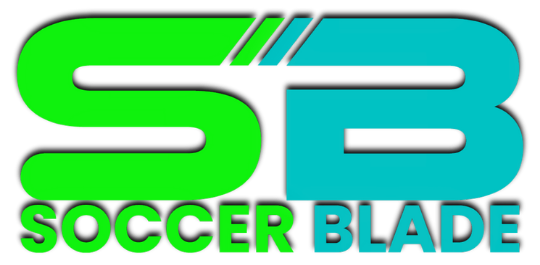Share the post "Soccer Drills for Beginners (+ Workouts and Exercises)"
Playing soccer is an art and must be practiced like anything else to be mastered. Be sure you’ve mastered the basic skills; that’s what the pros do best.
Advance your game with structured lessons with these soccer workouts for beginners that give you the core skills to improve.
First, we will look at beginner drills for single players, which can be done as a team, each player with a ball. Then we focus on team drills.
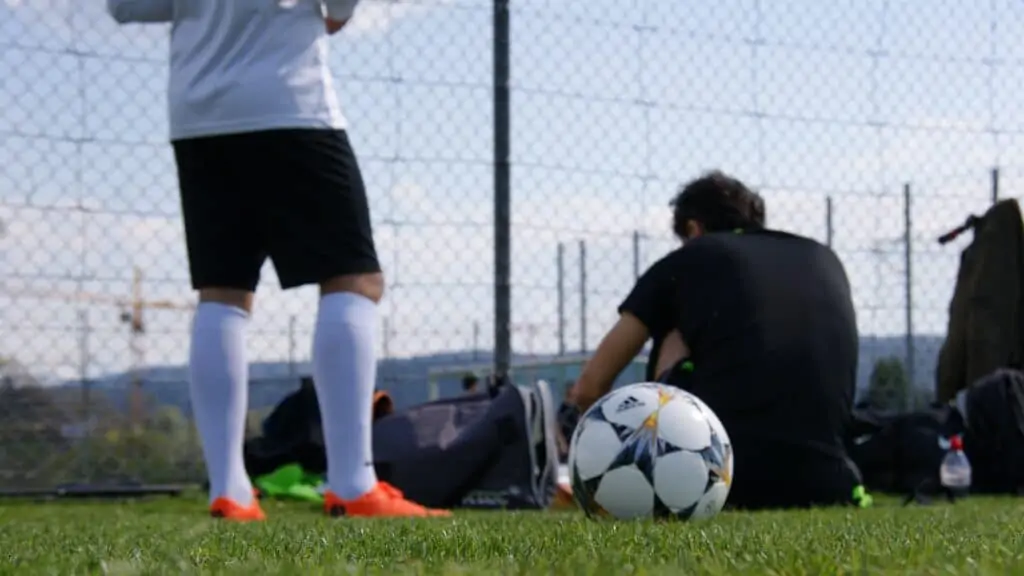
What are soccer workouts for beginners?
For individuals;
- Improve your passing technique with wall passing
- Dribble fast and straight with dribbling in lanes
- Strike like a pro with turning and shooting
For groups/teams;
- Critical Box Play – dribble, pass, and shoot
- Defensive Challenge – defense vs. attack
- Possession Retention – possession circle
Players canpractice these drills to advance from beginner to intermediate levels. You can perform the following beginnerworkouts to improve the different areas of your game.
Soccer Workouts for Beginners
Soccer is a team game, but we as players need the right skills to perform well within the team. Having these basic skills will make a team play effectively.
A striker is a player that depends on individual skills – mostly, they’ll have no players in front of them and will have to perform well on their own.
Often strikers are criticized for not being selfish – they need to take the opportunity when it comes.
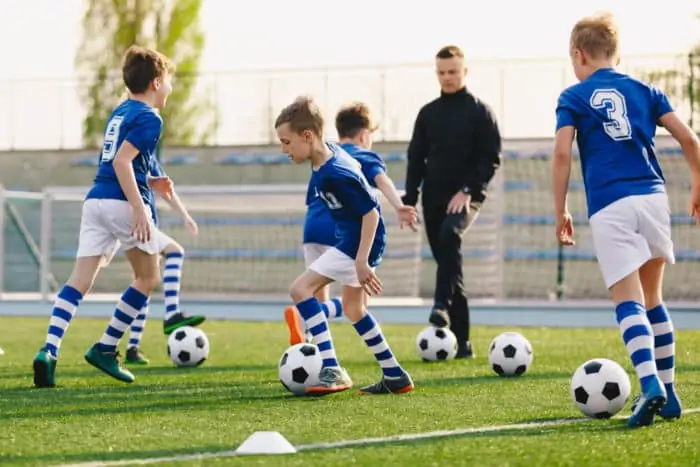
Passing Drill: Wall Passing
A simple yet effective solo drill with many variations, concentrating on different techniques and skills. All that’s needed is a ball and a wall.
One-Touch Wall Passing Drill Steps:
- The player should stand around 6 feet from a wall, gradually extending to 15 feet.
- The player picks a spot on the wall (mark it with chalk if possible) and passes the ball to that point.
- When the ball is rebounded, the player passes the ball back against the wall the first time. This is repeated.
- Passes in a row targets or a timer should be set. A good target is 10 passes up to 30+, or 30 seconds up to 2 mins.
- The player should practice using either foot.
Two-Touch Wall Passing Drill;
2-touch wall passing has the same concept as above, but it involves 2 touches instead of one: 1 touch to control the ball and 1 touch to pass it.
There are variations to this drill:
- All right foot. Use only your right foot to complete the drill.
- All left foot. Use only your left foot to complete the drill.
- Both feet. Use a combination of the left and right feet to control and pass the ball.
- Set out a cone or marker. The player passes the ball from behind the marker. The player waits for the ball to pass the marker/cone when it is rebounded back.
- Then uses their first touch to shift the ball from one side of the cone/marker to the other before playing the pass with their second touch. It’s important to use both feet in this variation.
Here is some high-quality training equipment for the soccer drills later. If you’re on a budget, get the set of balls – if not, I highly recommend getting multiple individual balls for the best enjoyment and longevity.
You might have some of the gear already. If not, I highly recommend these;
Best Youth Soccer Balls
Product: Updated 2024-07-21 | Images: Amazon Product Advertising API | #ad - soccerblade.com is an Amazon Associate
Best Soccer Youth Soccer Goals
Product: Updated 2024-07-24 | Images: Amazon Product Advertising API | #ad - soccerblade.com is an Amazon Associate
Dribble Drill: Lane Dribbling
This is a great workout for practicing in-game-type dribbling. It improves quickness and balance and helps develop ball control while running at speed.
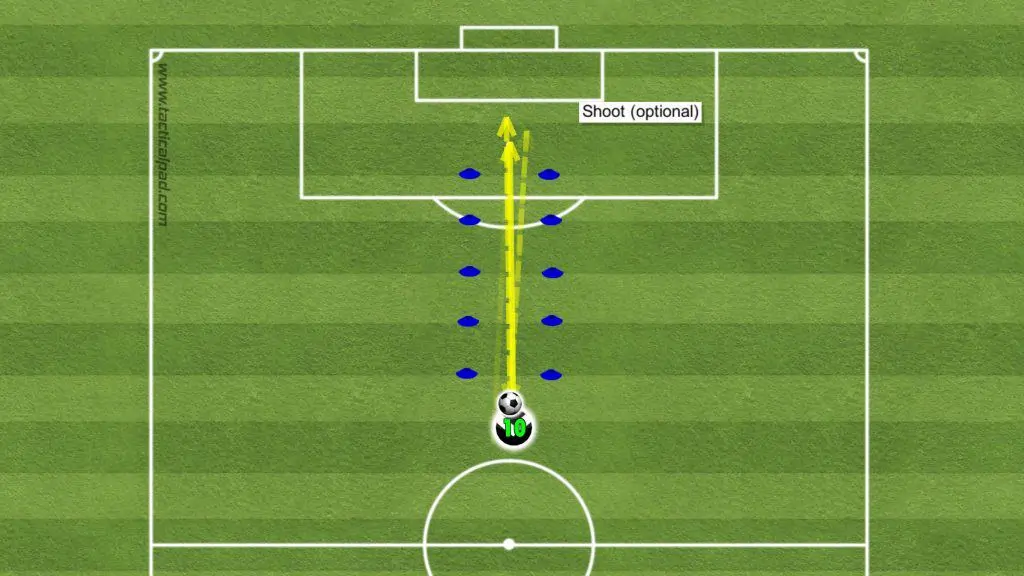
Dribbling Lane – Drill Steps:
- Make running gates using markers. The markers should be around 4 feet apart. Set out 4 gates, 15 feet from each other.
- Starting at the first gate, the player dribbles through each gate until they reach the end. Return to the starting point and go again.
- Speed is the focus but it has to be controlled. The player must have the ball under complete control at all times.
- The player needs to keep their head up, ensuring they run through each gate.
- He/she should start out slow and gradually build up speed, eventually dribbling as fast as they can.
Tips: Mix of long and short touches, utilizing the space while maintaining control of the ball – keep the ball under control.
Soccer Blade
Drill Extensions
- Shoot on goal or a cross afterrunning through the final gate
- Make the lane narrower every 5sessions
Extra Skills
For a variation and a full drill, a practice that’ll improve your dribbling in directions. Follow the video below, which will increase your;
- Speed
- Shooting
- Dribbling
Shooting Drill: Turn and Shoot
This is a useful shooting drill involving a quick turn, requires good ball control, and relies on a player’s positional awareness. A goalkeeper is good to have for advanced players but is not necessary.
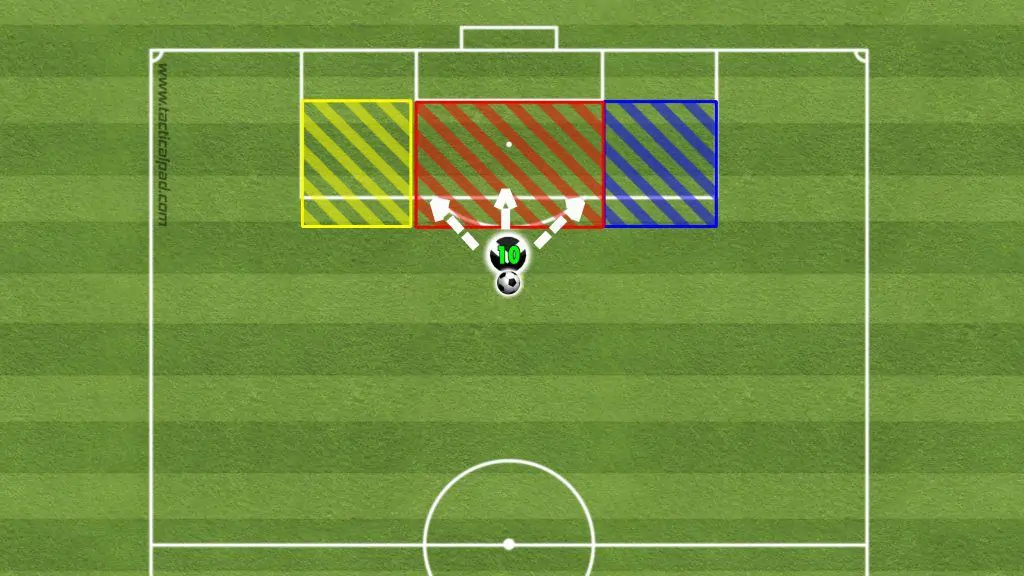
Turn and Shoot – Drill Steps:
- The player stands 18 yards from a goal with their back and the ball at their feet.
- To start the drill, the player takes a touch to turn goalward. The player can take one more touch before shooting or shooting with their second touch.
- After shooting, the player returns to the starting point and repeats the drill.
- The player should practice going in both directions and using either foot.
- Setting targets for scoring or hitting a shot on target is important. Once these are met, a player can change the starting position of the drill.
Team Drills For Beginners
The following workouts require at least two people but can be done in large groups. For the ones that involve shooting, a goalkeeper will come in handy.
Each of these workouts incorporates a combination of the 4 core skills mentioned earlier.
Dribble, Give, Go, and Shoot Drill
Main skillareas focused on:
- Controlled dribbling
- Speed
- Passing
- Shooting
- One-touch passing/shooting
3 main roles:
- Dribbler/Passer/Shooter
- Lay-off Passer
- Goalkeeper
Positions:
- Thedribbler(s)/passer(s)/shooter(s) (player 1) line up on the goal-line, at theedge of the penalty box.
- The lay-off passer (player 2)stands with their back to goal at the edge of the box.
- The goalkeeper takes theirplace in goal.
- A marker is placed 20 yardsfrom the dribbler(s), upfield.
Drill Layout:
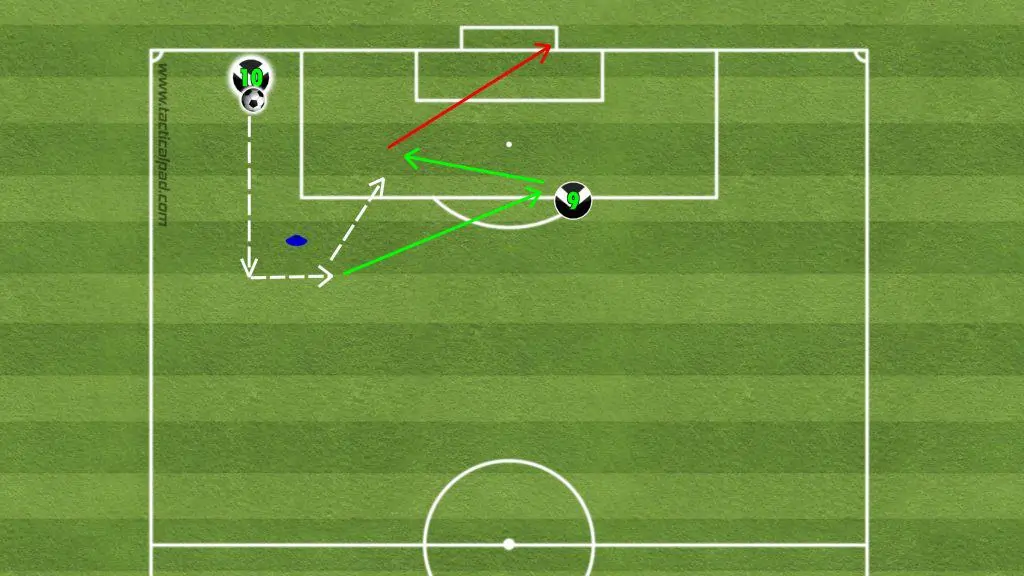
Drill Steps:
- The first dribbler/passer/shooter dribbles from the start point to a marker 20 yards away.
- Once they have reached the marker, the player rounds it and is now facing the goal.
- They make a pass to their teammate at the edge of the box, then immediately run goalward, communicating where they want to receive the return pass.
- The lay-off passer gives a first-time pass (if possible), teeing up the player 1 for a shot on goal.
- Player 1 shoots on goal first-time (if possible).
- Once all players in the dribbler/passer/shooter line have taken a shot, a player should switch with the lay-off passer.
Tips
- The aim is for this to be a fast, slick, one-touch move. Players should take as few touches as possible.
- However, if a poor or difficult-to-control pass has been played, the receiver should not force a difficult first-time pass or shot.
- They should control the ball first and then make their pass or shot.
- Communication is important for being accurate with passes.
- The goal shot should be coming from the edge of the penalty box or closer. This is not a long-range shooting drill.
Attack vs. Defense Drills
These drills are simple,, but when performed well, they can be extremely useful to a team’s attack and defense and improve individual skills.
3-On-2
There are 3 attackers versus 2 defenders (and a goalkeeper if there’s one available). This is why Barcelona’s tactics are the best.
The attacking team starts in possession around 30 yards from goal—the defense lines up on the edge of the penalty box. The attackers try to score while the defenders try to stop them.
Drill Layout;
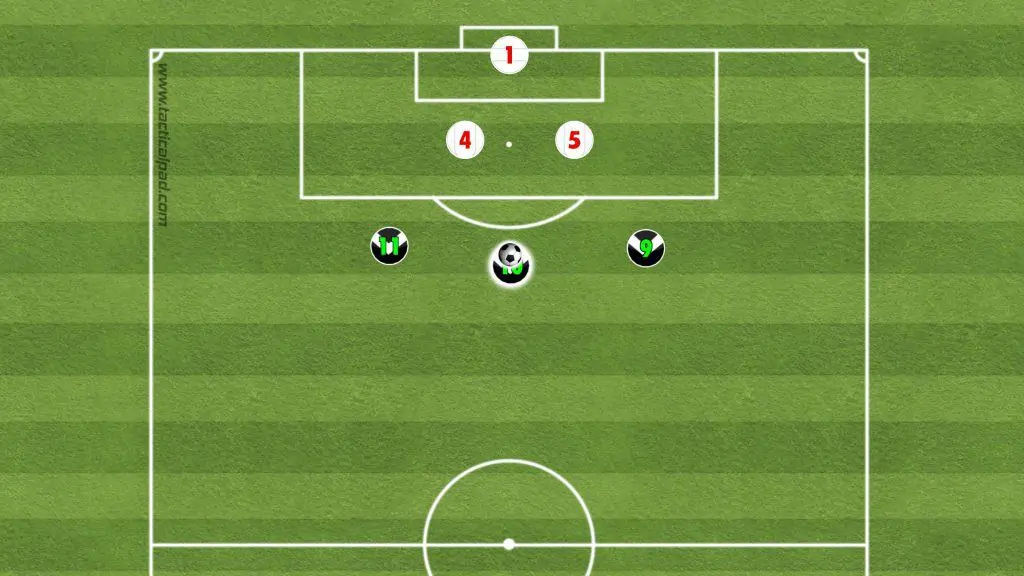
If possession is turned over, a goal is scored, or the ball goes dead, the round ends, and the drill can be restarted.
If the defense is successful, they should remain for the next round.
If the attacking team scores, they should remain for the next round. This workout is wasted without structure, organization, or team communication.
The attackers and defenders must coordinate and play as teams.
Notes/Tips:
Attackers
- Occupy positions stretch the defense, making the most of the numerical advantage.
- Pass and move quickly to create space and penetrate the defensive line.
- Be patient and wait for a good shooting chance. Avoid shooting from a distance and in difficult positions. Space will be available if the above tips are followed.
Defenders
- Communication is key. The defense is outnumbered, so they must work cohesively as a unit. The goalkeeper plays a big role here as they can see the full picture.
- The defense must be well-positioned and occupy central positions. If they’re dragged out wide, space will open up in front of the goal for the attackers.
- Defenders should not dive in or over-commit to tackles, leaving them exposed.
2-On-1
This is the same drill as above, with fewer players. In soccer, endless amounts of scenarios can occur. It’s just as important to drill 2-on-1 scenarios and 3-on-2 scenarios.
Possession Circle Drill
Teams and players complete this type of workout in training sessions daily. When done by the best players, this drill is a joy to watch.
The primary focus is on the attackers (passers), but this is also a very useful defensive drill.
Main skillareas focused on:
Attackers
- Quick passing
- Quality first touch
- Ball control
- Spatial awareness
- Vision
Defenders
- Tackling
- Interceptions
- Anticipation
- Quick feet
Positions:
- Attackers line up in a circle formation. It’s best to have a 3:1 or 4:1 ratio of attackers to defenders. The circle can start larger, getting smaller as the drill continues. However, the circle should not be too big.
- Defenders stand in the center of the circle.
Drill layout:
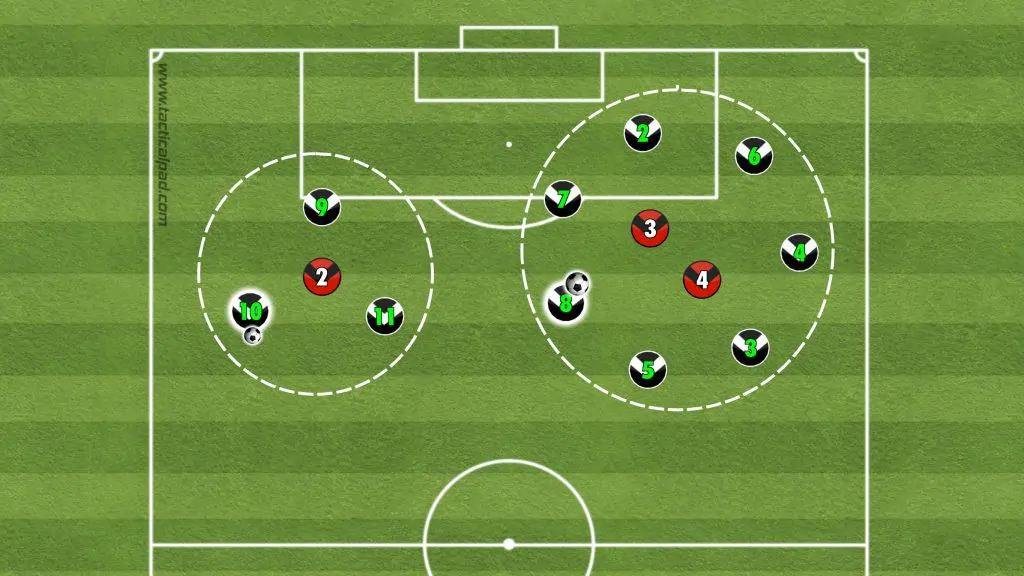
Twoexamples of possession circle workouts: 1 small group and 1 large group.
Possession Circles – Drill Steps:
- The attackers start with the ball and attempt to keep possession.
- The defenders chase the ball around, tackling and intercepting.
- If an attacker loses possession, they swap positions with the defender who caused the turnover.
- For the first 1 or 2 rounds, don’t count passes.
- After a few runs, set passing targets. Start with 10 and build your way up to 30+ passes if possible.
- Limit touches to 3 at first, then 2, then to 1 touch for the attackers.
- Make the circle smaller to increase the difficulty for the attackers.
Possession Circle – Tips
- Pass quickly. This drill’s purpose is to get players faster at passing the ball.
- The attacking team’s key is moving the ball quickly, taking as few touches as possible. The secret to this is to stay on your toes, take a quality first touch, and keep your head up to spot the next available pass.
- Communication is essential (as with most team-based drills).
- Defensively, the players must take up good positions and communicate effectively. Otherwise, they’ll find themselves wasting energy going for the same ball. Anticipation and being light on your feet will help massively.
How to be a good soccer player for beginners?
The key for soccer workouts for beginners here is simple:
- Be consistent with your workouts.
- Work on all aspects of your game.
- Concentrate on the specific skills practiced in each workout.
- Repetition! Keep your work rate high and maintain your practice routine.
- Practice makes perfect, so don’t sell yourself short.
- Be patient as you learn over time.
Finally, enjoy it. Take joy in your progression. Best of luck on your journey to becoming a better player. Enjoy the soccer workouts for beginners you’ll be successful with these tips.
See our new huge collection of soccer drills.
Related Questions
Do You Need To Practice On A Soccer Field?
Something can be done if you have a spare room in your house or a full soccer field to practice. In a small area, you can practice toe-taps, keepy-uppies, knees, and other footwork drills. It’s an advantage to have a soccer field at your disposal but it’s not a necessity.
Can You Practice Shooting Without A Goalkeeper?
When there is no goalkeeper, you need to set accuracy targets. Pick a spot in the goal and shoot there 10 times. Change the spot and shoot 10 times again. Repeat this, shooting to different areas of the goal without the goalkeeper.
Take note of how many times you hit your target. Try to beat this score the next time. When there is no goalkeeper, it’s also the perfect time to practice using your weaker foot.
Share the post "Soccer Drills for Beginners (+ Workouts and Exercises)"
Joel is a seasoned soccer journalist and analyst with many years of experience in the field. Joel specializes in game analysis, player profiles, transfer news, and has a keen eye for the tactical nuances of the game. He played at various levels in the game and coached teams - he is happy to share his insight with you.
